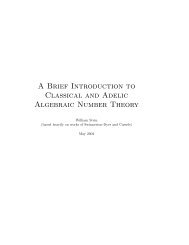A Short Course on Galois Cohomology - William Stein - University of ...
A Short Course on Galois Cohomology - William Stein - University of ...
A Short Course on Galois Cohomology - William Stein - University of ...
Create successful ePaper yourself
Turn your PDF publications into a flip-book with our unique Google optimized e-Paper software.
(iii) Let k be the maximal unramified extensi<strong>on</strong> K ur <strong>of</strong> a local field K with<br />
perfect residue field (e.g., the maximal unramified extensi<strong>on</strong> <strong>of</strong> a finite<br />
extensi<strong>on</strong> <strong>of</strong> Qp). Then Brk = 0. (See §X.7 <strong>of</strong> Serre’s Local Fields for<br />
references.)<br />
(iv) Let k be any algebraic extensi<strong>on</strong> k <strong>of</strong> Q that c<strong>on</strong>tains all roots <strong>of</strong> unity<br />
(thus k is necessarily an infinite degree extensi<strong>on</strong> <strong>of</strong> Q). Then Brk = 0.<br />
The following theorem is <strong>on</strong>e <strong>of</strong> the main results <strong>of</strong> local class field theory.<br />
Theorem 19.6. Let k be a local field with perfect residue field (e.g., a finite<br />
extensi<strong>on</strong> <strong>of</strong> Qp). Then Brk ∼ = Q/Z.<br />
The following theorem is <strong>on</strong>e <strong>of</strong> the main results <strong>of</strong> global class field<br />
theory.<br />
Theorem 19.7. Let k be a number field, and for any place v <strong>of</strong> k, let kv be<br />
the completi<strong>on</strong> <strong>of</strong> k at v, so kv is a p-adic local field, R, or C. We have a<br />
natural exact sequence<br />
0 → Brk → <br />
Brkv<br />
v<br />
(xv)↦→ P xv<br />
−−−−−−−→ Q/Z → 0,<br />
We obtain the map to Q/Z by using Theorem 19.6 to view each Brkv as<br />
Q/Z, and we view BrR = 1<br />
2 Z/Z.<br />
19.4 Brauer Groups and Central Simple Algebras<br />
Definiti<strong>on</strong> 19.8. Let k be a field. Then a central simple k-algebra is a finite<br />
dimensi<strong>on</strong>al k-algebra A that satisfies any <strong>on</strong>e <strong>of</strong> the following equivalent<br />
c<strong>on</strong>diti<strong>on</strong>s:<br />
(i) A has no n<strong>on</strong>trivial two-sided ideals, and A has center k.<br />
(ii) The algebra A¯ k = A ⊗k ¯ k is isomorphic to a matrix algebra over k.<br />
(iii) There is a finite extensi<strong>on</strong> F/k such that AF is isomorphic to a matrix<br />
algebra over F .<br />
(iv) A is isomorphic to a matrix algebra over a divisi<strong>on</strong> algebra D with<br />
center k.<br />
We say that two central simple k-algebras are equivalent if the corresp<strong>on</strong>ding<br />
divisi<strong>on</strong> algebras D in (iv) above are k-isomorphic. Tensor product<br />
endows the set <strong>of</strong> equivalence classes <strong>of</strong> central simple k-algebras with the<br />
structure <strong>of</strong> abelian group.<br />
40
















